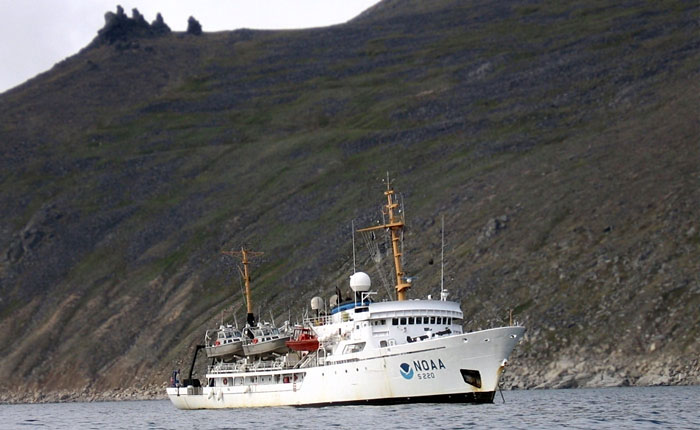
Last year, as a part of ongoing arctic research and, according to a news release from NOAA, due to “request[s] from the U.S. Navy, U.S. Coast Guard, Alaska Maritime Pilots and the commercial shipping industry” NOAA Ship Fairweather made the first of what will be many voyages into the arctic. She surveyed “350 square nautical miles in the Bering Straits around Cape Prince of Wales.” For the ship this was a refocusing of her ongoing mission to “conduct hydrographic surveys in support of nautical charting.”
According to the article titled “Polar ice packs” on Wikipedia, mid-summer ice area in the arctic has shown a decreasing trend over the last sixty years of recorded measures. In 2005 and 2007 the ice area minimum hit records 20% and 46%, respectively, below the 1978-2000 average minimum. The article also notes that in 2007 “for the first time in recorded history, the Northwest Passage opened to ships without the need of icebreakers.”

The record minimums of ice area in summer months and the expectations in the commercial industry of the continued annual decrease in ice area are major factors in a “doubling of Arctic commercial vessel traffic since 2005,” according to a news release from the National Ocean Service (NOS), a branch of NOAA. The arctic presents new and less expensive shipping routes. With “568,000 square nautical miles” of arctic waters within the U.S. Exclusive Economic Zone, most of which “has not been mapped since 1960, if ever,” a significant amount of work is required to make these new routes safe for commercial traffic.
In July of this year, after ice flows have sufficiently cleared, NOAA Ship Fairweather will be returning to the arctic to continue mapping in support of safe navigation within the arctic. The ship has not announced the area of focus for this year, but it will be north of the Bering Strait as the ship has in-ports scheduled for Kotzebue, Alaska.
I have photos of last year’s voyage into the arctic from Little Diomede, Tin City and Point Spencer. I will be joining the ship again this year and look forward to sharing more photos from coastal Alaska and the arctic.